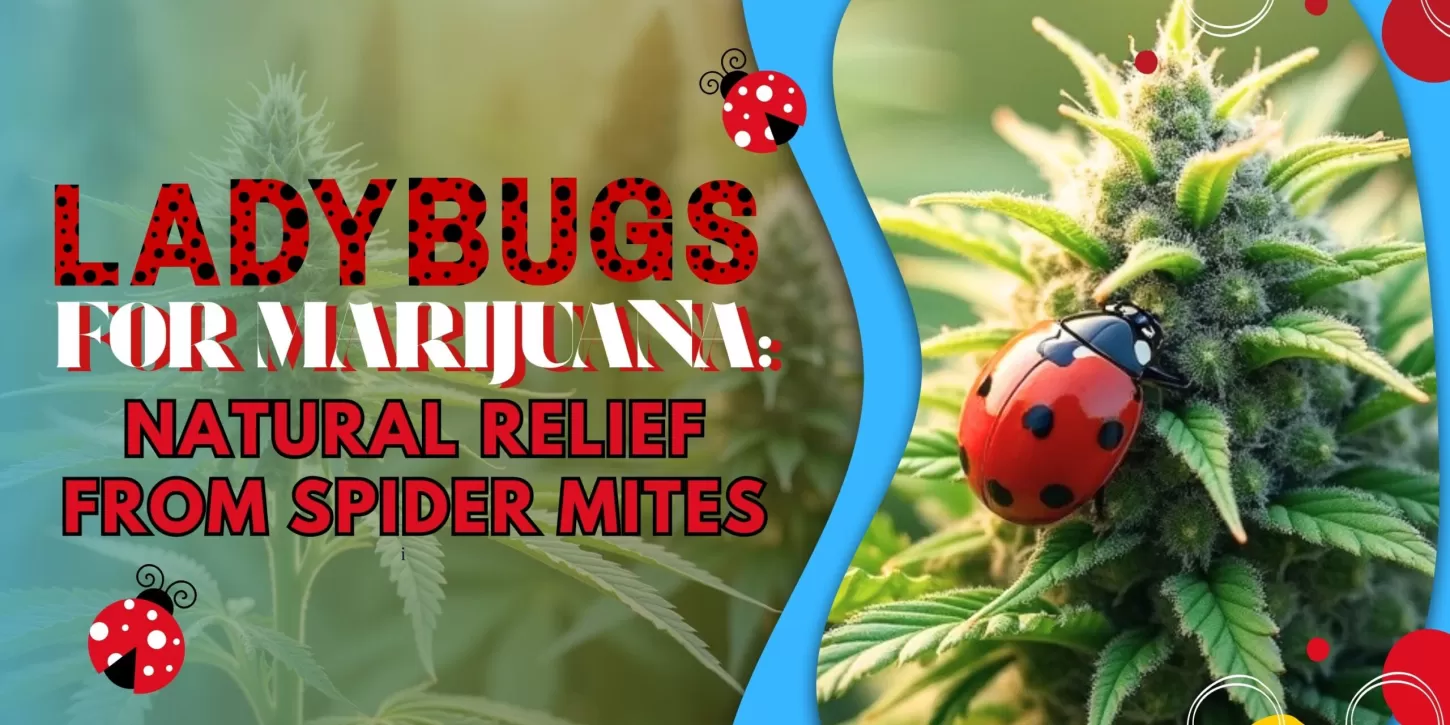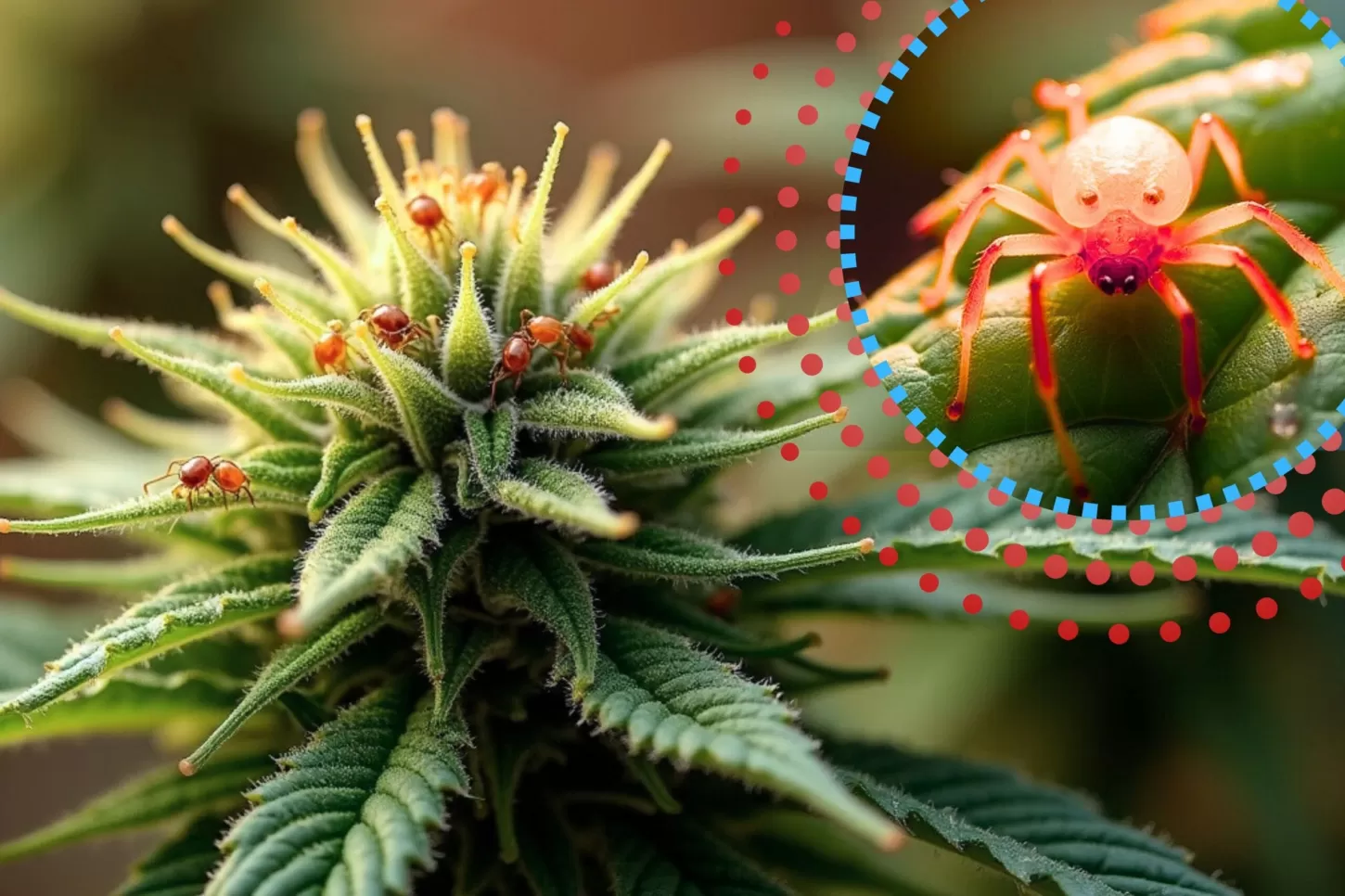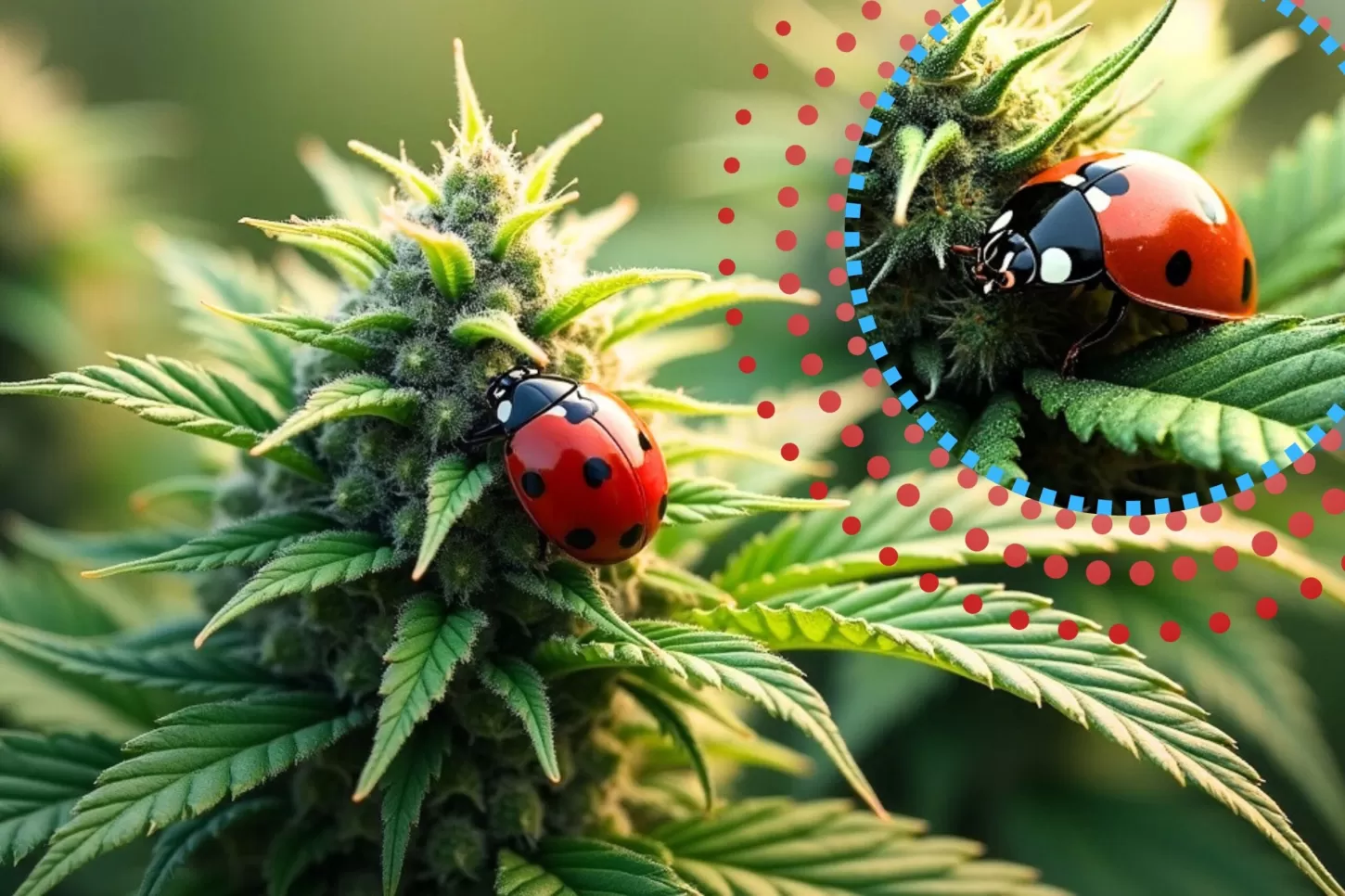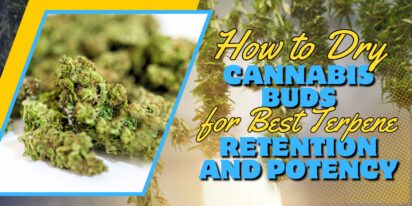Table of Contents

Growers of marijuana are increasingly seeking natural, chemical-free solutions for pest control, and ladybugs are among the most effective natural pesticides available. These voracious predators are not only a delightful addition to the grow room, but they also represent a first line of defense against ruinous pests like spider mites, aphids, and whiteflies. Here, we address how to use ladybugs and spider mites in cannabis cultivation, offering detailed, hands-on information on how to realize their potential as a biological control method.

Spider mites are some of the most destructive cannabis garden pests. Spider mites adore hot, dry weather and multiply rapidly. A single female spider mite will lay 100 or more eggs in a few weeks, and infestations will erupt overnight. Spider mites suck plant cell contents after injecting them with fluids, leading to chlorosis, leaf stippling, and ultimately necrosis.
Usually, infestations begin on the underside of the leaves and remain undetected until a fine webbing appears. The webs provide an armored environment for the mites, which are thus more difficult to manually remove. Apart from cosmetic damage, rampant mite infestations can result in stunted development, yield reduction, and lowered cannabinoid and terpene production.

Ladybugs (Coccinellidae) are among the best bio-pest control materials for organic growers of cannabis. The larvae and adults are both insatiable predators, consuming dozens of pests every day. They consume spider mites, aphids, thrips, and scale insects, as well as other soft-bodied pests infesting cannabis.
Having ladybugs forms a closed-loop ecosystem within the grow space. Ladybugs don’t leave residues on leaves or buds like chemical pesticides. They even adapt to pest pressure naturally through their lifecycle: when there’s pest buildup, the ladybugs multiply and adapt their quantity similarly.
Also, ladybugs do not damage cannabis plants and are thus safe to use during the vegetative or flowering stage. They are therefore suitable for indoor, greenhouse, and outdoor cannabis cultivation equally.
1. Obtaining Healthy Ladybugs
To perform best, ladybug cannabis should be bought from solid biological supply companies rather than gathered in the wild. Wild animals may be sick or less successful at pest control. Commercial ladybugs are commonly Hippodamia convergens, a North American lady beetle with a zealot appetite and broad adaptability.
2. Timing the Release
Ladybugs can be released in the evening or early morning, when temperatures are cool and light intensity is low. The process minimizes initial flight and will urge them to settle on the plants. Pre-release misting of the plants can also keep the insects suspended long enough for them to detect food sources.
3. Release Quantity
We recommend releasing around 1,500–2,000 ladybugs per 100 square feet of growing area. Repeat releases 5–7 days apart may be necessary for more severe infestations.
4. Environmental Conditions
To maintain ladybugs in active and reproductive condition, maintain 60–80% humidity and temperatures at 65–80°F (18–27°C). Chemical sprays before or after release should be avoided because residues will repel or kill beneficial insects.
In addition to these best management practices, it is essential to ensure that there is a supportive environment that promotes ladybug survival after release. Providing diverse plant types, some of which are supplemental foods such as pollen and nectar, increases the chances that a ladybug will remain longer. Avoiding the exposure of the ladybugs to wild environmental fluctuations or excessive amounts of fan airflow can enable acclimatization and active pest foraging without stress.
Ladybugs exhibit complete metamorphosis: egg, larva, pupa, and adult. All but the pupa stage help reduce pests. Larvae are particularly significant since they eat more pests than adults at this stage. From egg to adult, 3–4 weeks are needed, depending on temperature and humidity.
Environmental factors such as temperature and humidity directly affect the rate of ladybug development and the level of predation. Rising temperatures and constant conditions accelerate their life cycle and enable them to reproduce faster, improving their use for pest control at the best growing levels of cannabis.
Ladybug dispersal is one of the problems encountered in indoor environments. Some will fly towards lights or leave the site after release. There are a few ways to keep them from leaving:
Growers also supplement ladybugs with pollen, sugar water, or specialized insect foods in their diets to encourage population support.
It should also be noted that it is possible to construct microhabitats within the grow space—such as providing small mounds of leaves or shelters—so as to reduce dispersal through a supply of rest areas and hiding places for ladybugs. Gradual acclimation in the form of stepwise release can improve retention rates because mass releases all at once will lead to enhanced flight and loss.
Ladybugs may be integrated into broader Integrated Pest Management (IPM) applications. These other helpful insects, like Phytoseiulus persimilis (predatory mite), Amblyseius californicus, and lacewings (Chrysopidae), enhance the ladybug in suppressing more types of pests and different stages of life cycles.
For instance, while ladybugs primarily target soft-bodied adults and larvae, predatory mites target eggs and newly hatched pests. The combination of these species produces multi-layered pest control without chemicals.
The introduction of entomopathogenic fungi (e.g., Beauveria bassiana) and nematodes contributes to biological control methods, attacking soil-dwelling pests and insect stages that ladybugs cannot target. These diverse biological controls, well-timed and used in conjunction, create a long-lasting pest management system with low risk for resistance build-up and damage to the crop.
Periodic scouting is required. Inspect leaf undersides weekly with a magnifying glass or microscope. Sticky traps can be employed to monitor for flying insect pressure. If ladybugs are gone and pest populations rebuild, a second release will be required.
Avoid broad-spectrum fungicides, insecticides, or even organic oils when ladybugs are around. Neem oil, pyrethrins, and sulfur sprays are toxic to many beneficial insects. Aim instead for hand removal of the pests and spot treatment if necessary.
Meticulous recording of pest pressure, dates of ladybug releases, climatic parameters, and crop health will assist in providing useful data in an attempt to refine future biological control. Monitoring plant stress indicators and overall vigor can also help evaluate whether pest management practices are effectively minimizing damage and maximizing cannabis growth.
While ladybugs for spider mites can be helpful, they may not always be the best option. If your growing space is sealed and sterile, for example, in many hydroponic systems, adding insects can be at odds with operating procedures. In instances of severe infestation with high humidity levels, it is also advisable to first control the pest population with targeted methods before releasing ladybugs.
Ladybugs are less effective for managing hard-bodied insects such as beetles or caterpillars. In such cases, other biocontrol agents or mechanical controls are recommended.
Care should be taken to account for the specific conditions of your grow operation before release. Growers who have extremely sanitized or controlled systems, for example, may find other forms of biological or physical control preferable to maintain quarantine levels. Ladybugs also require prey to eat; release into pest-free environs can result in starvation and migration, which will reduce their effectiveness.
Ladybug application in cannabis cultivation offers a robust combination of sustainability, efficiency, and safety. Ladybugs are a chemical-free pesticide, improve garden diversity, and are organic gardening-friendly. Ladybugs as a dynamic, self-renewing solution to spider mites and other soft-bodied insects will be effective as long as they are obtained properly, released, and managed.
Their ability to coexist with other beneficial organisms and adapt to various growing conditions makes them a precious asset to beginners and experienced growers alike. As the art of cannabis growing moves in the direction of purer, greener methods, the humble ladybug is a prime example of nature’s balance—a precious friend in the quest for excellent, top-quality cannabis yields.

Curious about growing weed in a healthy, effective way? Welcome to the realm of weed hydro! This method uses water instead of soil, delivering n

Peyote Zkittlez is a unique cannabis strain that has quickly gained dedicated followers among enthusiasts and patients alike. Its parentage—Zk

As growers, we want strains that work well, are strong, and are of good quality. Autoflowering cannabis strains are a big step forward for both

Pot growers always ask the same basic question: How much weed does a weed plant produce? The answer is complex and depends on a multitude of var

Ever had the room spin after a few hits? You're not alone. Figuring out how to prevent getting dizzy high can make your cannabis experience a wh

Drying cannabis properly is a critical process in preserving the plant's full aroma and flavor and its psychoactive abilities. Tampering with th

Ever caught yourself a bit too high and all of a sudden in need of being normal? Whether you're heading out for munchies or bumping into someone

Looking for sage advice on how not to get pinched with weed without batting an eye? Attempting to protect your stash from gossipy roommates, sno

Nutrient lockout, also known as nutrient binding or chemical antagonism, is a significant issue in cannabis cultivation that negatively impacts

Germination is the most critical initial stage in growing healthy, high-quality cannabis plants. During germination, the dormant seed becomes a
Are You 18 Or Over?
By selecting “Continue”, you confirm that you are at least 18 years of age and legally permitted to access cannabis related content in your region.
By using Rocketseeds.com, you agree to our legal disclaimer.
Excellent blog here Also your website loads up very fast What web host are you using Can I get your affiliate link to your host I wish my web site loaded up as quickly as yours lol
Your writing is not only informative but also incredibly inspiring. You have a knack for sparking curiosity and encouraging critical thinking. Thank you for being such a positive influence!
Simply wish to say your article is as amazing The clearness in your post is just nice and i could assume youre an expert on this subject Well with your permission let me to grab your feed to keep updated with forthcoming post Thanks a million and please carry on the gratifying work
Somebody essentially lend a hand to make significantly articles Id state That is the very first time I frequented your website page and up to now I surprised with the research you made to make this actual submit amazing Wonderful task
Your blog is a beacon of light in the often murky waters of online content. Your thoughtful analysis and insightful commentary never fail to leave a lasting impression. Keep up the amazing work!
Thank you for the auspicious writeup It in fact was a amusement account it Look advanced to more added agreeable from you By the way how could we communicate
Your blog is a constant source of inspiration for me. Your passion for your subject matter shines through in every post, and it’s clear that you genuinely care about making a positive impact on your readers.
Your blog is a constant source of inspiration for me. Your passion for your subject matter is palpable, and it’s clear that you pour your heart and soul into every post. Keep up the incredible work!
Your articles never fail to captivate me. Each one is a testament to your expertise and dedication to your craft. Thank you for sharing your wisdom with the world.
Your blog is a testament to your dedication to your craft. Your commitment to excellence is evident in every aspect of your writing. Thank you for being such a positive influence in the online community.
Your writing has a way of resonating with me on a deep level. I appreciate the honesty and authenticity you bring to every post. Thank you for sharing your journey with us.
Your blog is a true gem in the world of online content. I’m continually impressed by the depth of your research and the clarity of your writing. Thank you for sharing your wisdom with us.
Hi i think that i saw you visited my web site thus i came to Return the favore Im attempting to find things to enhance my siteI suppose its ok to use a few of your ideas
Somebody essentially help to make significantly articles Id state This is the first time I frequented your web page and up to now I surprised with the research you made to make this actual post incredible Fantastic job
Usually I do not read article on blogs however I would like to say that this writeup very compelled me to take a look at and do so Your writing taste has been amazed me Thanks quite nice post
Your blog has quickly become one of my favorites. Your writing is both insightful and thought-provoking, and I always come away from your posts feeling inspired. Keep up the phenomenal work!
Every time I visit your website, I’m greeted with thought-provoking content and impeccable writing. You truly have a gift for articulating complex ideas in a clear and engaging manner.
Hey there You have done a fantastic job I will certainly digg it and personally recommend to my friends Im confident theyll be benefited from this site
I have read some excellent stuff here Definitely value bookmarking for revisiting I wonder how much effort you put to make the sort of excellent informative website
Nice blog here Also your site loads up very fast What host are you using Can I get your affiliate link to your host I wish my site loaded up as quickly as yours lol
What i do not understood is in truth how you are not actually a lot more smartlyliked than you may be now You are very intelligent You realize therefore significantly in the case of this topic produced me individually imagine it from numerous numerous angles Its like men and women dont seem to be fascinated until it is one thing to do with Woman gaga Your own stuffs nice All the time care for it up
Your blog is a beacon of light in the often murky waters of online content. Your thoughtful analysis and insightful commentary never fail to leave a lasting impression. Keep up the amazing work!
Your blog is a breath of fresh air in the often stagnant world of online content. Your thoughtful analysis and insightful commentary never fail to leave a lasting impression. Thank you for sharing your wisdom with us.
Your blog is a beacon of light in the often murky waters of online content. Your thoughtful analysis and insightful commentary never fail to leave a lasting impression. Keep up the amazing work!
Usually I do not read article on blogs however I would like to say that this writeup very compelled me to take a look at and do it Your writing style has been amazed me Thank you very nice article
Your writing has a way of resonating with me on a deep level. I appreciate the honesty and authenticity you bring to every post. Thank you for sharing your journey with us.
This hydroponics guide is quite the buzz, seriously! Who knew growing weed without dirt could be so complicated yet potentially rewarding? The breakdown of systems like DWC and NFT is helpful, though I suspect my cat might confuse the air pump for a toy. The idea of cleaner buds is tempting, especially since explaining hydro weed to my non-growing friends might get messy. And the bit about potential dizziness from hydro weed? Perfect, now I have an excuse for why I always stumble a bit after a grow session. Still, the promise of faster grows and higher yields is hard to ignore, even if it means more trips to the pH meter than to the coffee shop. Overall, a cultivating read for the curious grower!